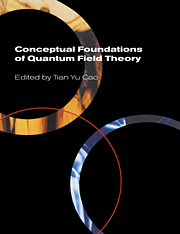Book contents
- Frontmatter
- Contents
- List of contributors
- Preface
- Photographs of the conference
- Introduction: Conceptual issues in quantum field theory
- Part One Philosophers' interest in quantum field theory
- Part Two Three approaches to the foundations of quantum field theory
- Part Three
- Part Four Mathematics, statistics and quantum field theory
- Part Five Quantum field theory and space-time
- Part Six
- 16 What is quantum field theory, and what did we think it was?
- 17 Comments
- Part Seven Renormalization group
- Part Eight Non-Abelian gauge theory
- Part Nine The ontology of particles or fields
- Part Ten
- Name index
- Subject index
16 - What is quantum field theory, and what did we think it was?
Published online by Cambridge University Press: 22 September 2009
- Frontmatter
- Contents
- List of contributors
- Preface
- Photographs of the conference
- Introduction: Conceptual issues in quantum field theory
- Part One Philosophers' interest in quantum field theory
- Part Two Three approaches to the foundations of quantum field theory
- Part Three
- Part Four Mathematics, statistics and quantum field theory
- Part Five Quantum field theory and space-time
- Part Six
- 16 What is quantum field theory, and what did we think it was?
- 17 Comments
- Part Seven Renormalization group
- Part Eight Non-Abelian gauge theory
- Part Nine The ontology of particles or fields
- Part Ten
- Name index
- Subject index
Summary
Quantum field theory was originally thought to be simply the quantum theory of fields. That is, when quantum mechanics was developed physicists already knew about various classical fields, notably the electromagnetic field, so what else would they do but quantize the electromagnetic field in the same way that they quantized the theory of single particles? In 1926, in one of the very first papers on quantum mechanics, Born, Heisenberg and Jordan presented the quantum theory of the electromagnetic field. For simplicity they left out the polarization of the photon, and took space-time to have one space and one time dimension, but that didn't affect the main results. (Comment from audience.) Yes, they were really doing string theory, so in this sense string theory is earlier than quantum field theory. Born et al. gave a formula for the electromagnetic field as a Fourier transform and used the canonical commutation relations to identify the coefficients in this Fourier transform as operators that destroy and create photons, so that when quantized this field theory became a theory of photons. Photons, of course, had been around (though not under that name) since Einstein's work on the photoelectric effect two decades earlier, but this paper showed that photons are an inevitable consequence of quantum mechanics as applied to electromagnetism.
The quantum theory of particles like electrons was being developed at the same time, and made relativistic by Dirac in 1928-1930.
- Type
- Chapter
- Information
- Conceptual Foundations of Quantum Field Theory , pp. 241 - 251Publisher: Cambridge University PressPrint publication year: 1999
- 42
- Cited by



